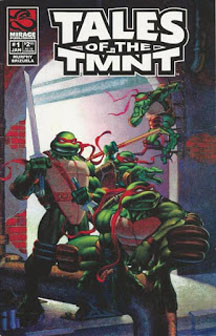For the editors at Mirage Comics, it was both a blessing and a curse that most of their readership got hooked on TMNT through the cartoons and Archie comics: A blessing because they got new readers, a curse because a lot of those readers had a hard time differentiating between the original material and the licensed material.
Many letters in Mirage Volume 4 and “Tales of the TMNT” Volume 2 request appearances by non-Mirage characters ranging from Ace Duck to Ninjara, and I can sense the deep sigh and 10-count before each of Peter Laird’s responses.
Now, as I embark on my exploration of the 70-issue run of “Tales” Volume 2, that’s not to say that every Mirage creation beats every cartoon or Archie invention. For example, Issue 15 (“Hell’s Blacktop”), written by “Tales” editor Steve Murphy (as are all of the issues in this batch, unless I note otherwise) is not my thing at all.

“Tales of the TMNT” Volume 2 Issues 1-18 (2004-05)
Writers: Stephen Murphy, Rick Remender, Jim Lawson, Eric Talbot, Dan Berger, Peter Laird, Scott Cohn, Doug Rice
Pencils: Dario Brizuela, Jim Lawson, Rick Remender, Chris Allan, Dan Berger, D’Israeli, Scott Cohn, Mike Manley, Doug Rice
Inks: Dario Brizuela, Eric Talbot, John Beatty, Peter Laird, Chris Allan, Dan Berger, D’Israeli, Sean Parsons, Mike Manley, Hilary Barta, Phil Moy, Cory Carani, Jim Lawson
This Heavy Metal-ish tale introduces demon hot-rodder Von Clutch and his headless girlfriend Darlin’ in what is very much a spiritual sequel to Rick Veitch’s “Sky Highway,” which I didn’t much care for either.
Starting at the beginning
While “Tales” Volume 2 ventures all over the timeline (that’s the point of the free-wheeling series, after all), it appropriately starts at the beginning of the timeline with Issue 1 (“Not Forgotten”), where the pre-teen Turtles are allowed by Splinter to explore the sewers on their own for the first time.
They meet a race of fish mutants (related to those in Volume 1, Issue 28, or Volume 2, perhaps) and Donnie shows them how to purify their water supply. The exploration of sewer tunnels is the fun part for a reader.
Although we’re still lacking the ultimate Mirage Splinter yarn, the old rat shows he’s still got it as he fights off bad guys in Issues 2 (“Seeds of Destruction”) and 11 (“The Quick and the Dead”), both of which feature Foot Mystics – something that ties in nicely with one of the major Foot villains from the Image run, Cheng (don’t tell Peter Laird, though!).
If there’s a notable theme in this batch of “Tales” issues, it’s the Turtle-verses’ expansion into the supernatural. Of course, such elements date back to Volume 1, Issue 9, when Splinter swaps bodies with a Japanese guy, but now many issues feel like they could be “Buffy” or “X-Files” short stories – which is not a bad thing, so long as it leads to a good tale.

For example, I’m OK with the pseudo-vampires in Volume 4, because they create Feral Raph, who ends up having a good character arc.
Shadow emerges from shadows
The first two years of “Tales” Volume 2 do a great job showcasing original Mirage characters, particularly April and Casey’s adopted daughter Shadow, who is easily the best unique-to-Mirage character.
I like the way she goes through the traditional teen adventures, but with four mutant turtles as protective uncles and a mutant rat as a grandfather. She takes the classic TMNT theme of “makeshift family” into the next generation.
In Issue 7 (“Darkness Weaves”), a story referenced in a throwaway line by Laird in Volume 4, Shadow sneaks off to a rock concert only to be almost turned into a werewolf along with the rest of the worshipful female audience, and in Issue 12 (“Paris Nocturne”), she encounters demons in a Paris sewer.
Raph is the uncle primarily tasked with protecting her – after all, Shadow reminds him of himself at that age — even going so far as traveling to France by hiding in the plane’s baggage hold.
Sticking with the horror theme, the Turtles encounter more products of the Foot’s worm-clone technology from “Return to New York” in Issues 3 and 4 (“Worms of Madness,” Parts 1 and 2), and the Donatello-starring Issue 10 (“Kaddish”) is your basic out-of-control golem story.
Since I’m not a scholar of Jewish religious lore, it’s remarkable how many times I’ve come across the golem story; for one, “The X-Files” did an episode by the same name as this issue.
The Utroms’ dark secret
Raphael’s France vacation is a short jaunt compared to Donatello’s space travels with Utroms and Professor Honeycutt (Fugitoid) in Issue 16 (“Sins of the Past”), where we learn a dark secret of the Utroms: They once wiped out an entire rival species — albeit one so violent by nature that it needed to be wiped out.
And Raph, Don and Casey go to another dimension – courtesy of an experiment by a clumsy Utrom drunk on cranberry juice – and fight giant spiders in Jim Lawson’s Issue 17 (“Wrong Turn”). When the Utroms oh-so-politely invade Earth early in Volume 4, I thought there was something fishy about them, but now I’ve accepted they are good guys. They’ve passed up way too many opportunities to kill our heroes to be evil.
Speaking of the Utroms, their old pal Leatherhead returns in Issue 8 (“Virus,” by Dan Berger). It’s hardly a story in itself, but rather the second chapter in the Leatherhead trilogy (“TMNT” Volume 1, Issue 45 is the first and “Tales” Volume 2, Issue 23 is the last). Here, the emotionally unstable Leatherhead gets kidnapped by his makers, the Utroms, but we don’t know why.
More intriguing is the female ninja who steals the tail of Raph’s bandana then playfully taunts him while he angrily chases her through the sewers. She’ll turn out to be Hana, the niece of Hamato Yoshi, as we’ll learn in Issue 34. Raph battling a cold is a nice detail.
The Utroms pop up again in Issue 18 (“The Blue Hole,” Murphy), an imaginative but inconsequential sci-fi yarn set during the Volume 4 period. Don and Utrom scientist Glurin discover an artificial black hole in the waters of the Bermuda Triangle, then are rescued by a gigantic sea turtle.
Murphy – whose tendency to always find something to be afraid of is present even in his editorials and letter-column responses (Terrorism! Bird flu!) — doesn’t miss the opportunity for a lecture about sudden climate change. But at the same time, he gives fascinating information about how creatures we consider to be non-sentient might on some level show reason and empathy.
Leonardo’s troubles and sorrows
In addition to Shadow’s werewolf adventure, Laird’s other big tease-to-an-untold-story in Volume 4 is Cha Ocho, a high-ranking Foot soldier who clearly has a dark history with Leonardo. Issue 6 (“Scars”) is perhaps the most compelling story from the first two years of “Tales” Volume 2, even though it’s the first Mirage effort where Murphy uses his pseudonym Dean Clarrain.
“Clarrain” and artist Chris Allan had developed a following for their Archie “TMNT Adventures” work a decade earlier. (I feel bad for the letter writers who keep asking for “The Forever War,” a completed but unreleased “Adventures” story. Murphy keeps saying it’s in the works, but it still has never been released.)
Leonardo shows a high level of hypocrisy in “Scars,” but it actually makes him a more interesting character. He chastises Cha Ocho for hunting down and killing the common crook who had accidentally killed his wife, even purposely giving Cha “a mark of shame” with a knife-slash across his face. Cha calls him out:
Cha Ocho: “But you and your brothers killed Oroku Saki for the sake of your master’s vengeance! You even killed him a second time! How can you deny me my vengeance?!”
Leo: “Because I have learned that vengeance sows the seeds of future sorrow.”
It’s also worth noting that Leo, after being blinded by a vengeful Shredder Elite, accidentally kills a homeless man in Lawson’s Issue 5 (“Blind Faith”), which is drawn entirely in silhouette by Lawson. While we don’t immediately see Leo dealing with that killing in “Tales,” it is picked up in the “Leonardo: Blind Sight” four-issue series.
More of Leo’s “future sorrow” is explored in Murphy’s Issues 13–14 (“Loops” Parts 1 and 2), which finds Leonardos of four different ages (8, 15, 45 and 100) mystically thrown together into a time-travel (and perhaps dimension-travel?) mission to deliver a gem to an ancient Egyptian talking monkey (It’s actually not as confusing, or as bad, as it sounds).
The banter between the four Leonardos is entertaining, and the Leos could be stand-ins for any person at those particular points in their lives – a scared youngster, a teenager who believes anything is possible, a cynical adult and wise elder.
As is common with Mirage’s depictions of the Turtles in their older years, the eldest Leo is both the saddest and the wisest. “I vowed long ago never to take another sentient life,” Old Leo tells his younger selves before knocking out an opponent with a non-lethal energy weapon, a 100th birthday gift from Donatello.
(The younger Leos would not remember Old Leo’s advice, due to a quirk of interdimensional travel.)
This tale isn’t a Klunker
Leo might be the star, but the best issue of this batch features Mikey. Jim Lawson’s Issue 9 (“The Path”) had many Turtles fans admitting in the letters column that they cried. It chronicles the death of Klunk, Mikey’s cat who was introduced way back in the Michaelangelo one-shot in the 1980s, before Peter Laird corrected the spelling.
Here, Mikey finds that he can’t bring it upon himself to sacrifice a scraggly alley cat to a mystic healer in exchange for Klunk’s life.
Additionally, we get some fine insight into Splinter: Even as he teaches Mike about how a warrior must sometimes set aside his inner goodness (perhaps addressing the Volume 1, Issue 1 introduction of Splinter as someone willing to sacrifice his sons for the sake of revenge), he also expresses admiration for Mike’s ability to walk these conflicting paths.
So who needs Ray Fillet, Jagwar and Bellybomb when you’ve got Shadow and Cha Ocho and Klunk? “Tales” proves that Mirage alone is a treasure trove of great characters, even if it didn’t lead to as many action figures as the cartoon and Archie comics did.

